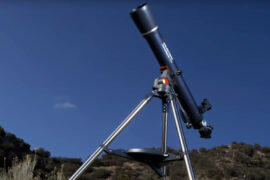The Pisces constellation is one of the better-known groups of stars in the sky. This is because it is located in an imaginary “belt” in the sky around Earth that we call the ecliptic. This ecliptic is the extension of the path that Earth follows as it orbits the Sun.
Because of this position in the sky, Pisces is considered one of the twelve zodiac constellations. These constellations are the ones the ecliptic crosses through.
Pisces is also known as “the fish”. The stars are supposed to form the shape of two fishes and are associated with the myth of Aphrodite and her son Eros, who escaped from the monster Typhon by jumping into the Euphrates river and shape-shifting into fishes.
| Name | Pisces |
| Abbreviation | Psc |
| Genitive | Piscium |
| Meaning | The Fish |
| Main stars | 18 |
| Bayer stars | 86 |
| Discovered stars with planets | 13 |
| Brightest star | Alpherg (Eta Piscium) |
| Location | Quadrant NQ1 |
| Visible latitudes | +90 to -65 |
| Meteor showers | Piscids |
| Neighboring constellations | Triangulum, Andromeda, Pegasus, Aquarius, Cetus, Aries |
When and where is the Pisces constellation visible
Capricornus is visible in the sky between June and February. The best time to watch it is in November when it can be found directly overhead at around 9:00 PM.
Pisces is located in the northern square NQ1 in the sky and can be seen between the latitudes of +90 to -65. This means it can be seen from anywhere in the world with the exception of Antarctica.
The following table details the times and general direction where the constellation can be seen each month of the year. The table works for all of the Northern hemisphere (U.S., Europe, Canada) and the times might slightly vary depending on your location but not by much.
| January | Visible overhead at sunset; sets in the west around 1:00 AM |
| February | Visible slightly west at sunset; sets in the west around 00:00 AM |
| March | not visible |
| April | not visible |
| May | not visible |
| June | Rises in the east around 4:00 AM; visible until sunrise |
| July | Rises in the east around 3:00 AM; visible until sunrise |
| August | Rises in the east around 1:00 AM; visible overhead around sunrise |
| September | Rises in the east around 10:30 PM; can be seen heading west by sunrise |
| October | Rises in the east around 8:00 PM; sets in the west around sunrise |
| November | Can be seen east at sunset; sets in the west around 5:00 AM |
| December | Can be seen east at sunset; sets in the west around 3:00 AM |
As you can see from the table, the constellations travel in the sky from East to West just like the Sun and the Moon. Between December and February, Pisces is already up in the sky by sunset so you will not see it rise from the horizon.
Between March and May, the constellation passes behind the Sun, making it impossible for us to see it from Earth.
While Pisces is a constellation that covers a big area, it doesn’t have many bright stars. This makes it harder to find in big cities and places with high levels of light pollution. If you are in a city environment where you can’t see many stars at night, using binoculars or a telescope might be necessary to find it.
How to find Pisces in the sky
Pisces has two distinctive features that can be used to recognize it. Its big V shape which is one of the largest formations in the sky, and the head of the west fish, which is a group of five stars that form a circle or an irregularly shaped pentagon.
Method 1: The ecliptic line
The most effective method to find Pisces in the sky is to find the ecliptic line. Pisces passes right through it. The problem with this method is that it requires a bit of time and patience if you want to do it without any tools like a star map. The upside is that you will be able to find any of the zodiac constellations with the same method so you get a 12 by 1 deal.
The ecliptic is the imaginary line Earth follows around the Sun as it orbits it. If you think about it, this means the Sun, the Moon, and the planets in the Solar system that we can see from Earth, also follow approximately the same path.
So, all you need to do to find the ecliptic is look at any of these objects and wait some time to observe how it moves. Trace the path it follows and extend it and that’s the ecliptic.
The best time to do this is right at sunset, where you can have two points of reference because both the Sun and the Moon can be seen.
Mars is also a good choice to track the ecliptic when it can be seen because it is easy to recognize thanks to its red-ish tone.
Because of Earth’s curvature, the ecliptic is also going to be a curved line, so take that into consideration when tracing it.
Once you have traced the ecliptic, simply check your local time and compare it with the table above to make sure that Pisces is visible at the moment, and in what direction you should look for it.
Method 2: The Summer Triangle (Summer and Fall)
As mentioned, Pisces is formed by relatively dim stars, so recognizing its shape right away can be a bit tricky.
But you can use brighter constellations and asterisms first, and use them to star hop to find Pisces.
The Summer Triangle is a very well know asterism formed by 3 of the brighter stars in the sky: Altair, Deneb, and Vega.
This triangle is very easy to recognize, especially during the Summer months, where it can be found exactly overhead around midnight. In Spring it can be found to the West after Sunset, and in the Fall it can still be seen in the West for a few hours in the evening. It can’t be seen in Winter so this method is not going to work during those months.
Once you have located the Summer triangle, trace an imaginary line from Vega that “splits” the triangle perpendicular to the base formed by Altair and Deneb.
This line points almost exactly to the head of the west fish in Pisces.
Along the way, you might also recognize four bright stars making an almost perfect square. This is the body of Pegasus and it means you are going in the right direction.
Method 3: Orion (Winter)
During the winter months when the Summer Triangle is not in the sky, there’s another path you can use to locate Pisces.
First, you will need to locate Orion. The easiest way to do this is to find Orion’s Belt. These are a group of 3 very bright stars lined up very close to each other. There’s no other formation like this in the night sky with such bright stars and in some countries, people are taught to recognize it since the time they are kids because around Christmas they represent the legend of the 3 wise men.
Once you have located the belt, you will need to imagine the rest of Orion and you are going to locate the two stars that make up its arm. These are Bellatrix and Pi Orionis. Extend the imaginary line that connects these two stars and follow it.
This line points almost exactly to the intersection of the V shape in Pisces. Once you have found that, you can trace the rest of the constellation.
Viewing Pisces through a telescope
Unfortunately, Pisces doesn’t contain many deep-sky objects (galaxies, nebulas, etc) to check out in its area that are easy to see.
The ones that are there, like the galaxy M74, NGC 488, and NGC 520 are not too bright so you will need a very powerful telescope and perfect sky conditions to catch them. The easiest one to check out is NGC 520, which actually a pair of galaxies colliding with each other. It has a magnitude of 12.2 which means a decent home telescope might be powerful enough to see it.
As for meteor showers, Pisces doesn’t have too much to offer either. A meteor shower called the Piscids occurs during September and October. The best times to watch it are September 8, September 21, and October 13, however, the shooting stars are few and not too bright. They can be seen with a telescope, but there are much better meteor showers to look for like the Taurids.
How to find more constellations
Aries – Taurus – Gemini – Cancer – Leo – Virgo – Libra – Scorpius – Saggitarius – Capricornus – Aquarius – Pisces










